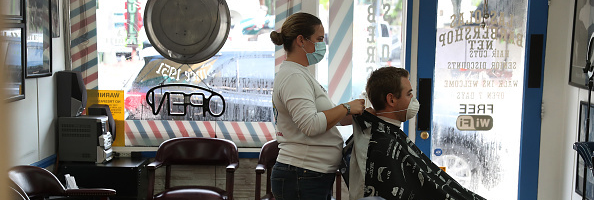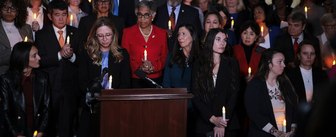COVID–19 arrived in the United States first and hardest in its urban counties, especially in the Northeast, leaving behind very high rates of infection and death. As the virus has spread, higher rates of infection are increasingly occurring in a “checkerboard” of more rural and more Republican counties.
Yet, this geographic transformation of coronavirus has not produced similar shifts in opinion, according to a YouGov analysis of surveys conducted on behalf of Yahoo News. People who live in places where COVID–19 struck early remain more worried about it than those elsewhere, where political partisanship appears to be a far bigger influence. More importantly, while the geography of coronavirus’ spread shows some impact on President Donald Trump’s overall handling of the virus, the differences are slight.
By April 5, 225 US counties had reached or exceeded a high prevalence of coronavirus (defined as at least 100 cases per 100,000 population). These disproportionately urban and racially diverse counties account for 21 percent of the US population. Their party identification tilts two-to-one Democratic (47% to 23%, including leaners); most describe their local area as a city (43%) or suburb (36%); and two in five are black (15%), Hispanic (19%), or a race other than white (7%). Better than half the population of these counties are in the northeast United States.
Another 1,379 counties attained high coronavirus prevalence between April 6 and May 20, accounting for better than half (59%) of the US population. Just 9 percent of people in these counties live in the Northeast, while 42 percent live in the South. Many are suburban (38%) but comparatively fewer than those in early spread counties are urban (32%), Democratic (44%), or a racial minority (37%).
The remaining 1,538 counties that were still low in coronavirus prevalence as of May 20 have a population that is more rural (39%) than urban (18%), and more Republican (40%) than Democrat (33%) and just one in five (20%) are racial minorities. Just 8 percent live in the Northeast, and 42 percent live in the South.
So, how have worries about the coronavirus varied across these three clusters of geography over time? The most striking feature is the similarity. In all three categories, worries about coronavirus rose sharply during March, peaked in early April, and have slowly declined since.
Geography does appear to matter, however, in the way it appears to affect the levels of concern over time. Specifically, the overall level of worry remains roughly ten percentage points higher among the early incidence counties, those which attained high per-capita COVID-19 case prevalence (before April 5).
That said, a small gap does appear to merge between the second and third population segments — the counties that attained a high coronavirus prevalence later (between April 6 and May 20) and those that remained low incidence as of May 20. Concerns about coronavirus declined at a slightly faster rate in the still-low-incidence counties than those in the middle category, and the gap emerged in late April and early May, exactly when coronavirus attained high prevalence in the middle category counties.
Some may question whether the greater worries observed in the heavily urban and Northeast early-onset counties may simply reflect their partisanship. Democrats have typically been 20 or more percentage points more worried about coronavirus than Republicans, so perhaps this difference in composition explains the higher level of concern in early-onset areas.
The trends do look somewhat different when we control for party identification. Among Democrats and Democratic leaners, concerns are consistently very high, the trend is flatter. The level of worry rose to high 80s and low 90s by early April – and has shown very little decline since, except among Democrats in areas where COVID-19 prevalence has remained low, who show a slightly greater decline in worry.
Among Republicans and Republican leaners, however, the pattern is different. Republicans show far more volatility in their COVID worries – more of an increase than Democrats from March to April and more of a decline since – and larger and more consistent differences by category of the county. And the gap between the early onset and other areas is much greater. Republicans in the first wave of high-prevalence counties express consistently more worry about coronavirus (roughly 10 to 20 percentage points more, on average) than Republicans elsewhere.
Another complication: Republicans in the heavily urban and Northeast early-onset counties are different. They are less likely to describe themselves as conservative (57%) and less likely to report having voted in 2016 (61%) than Republicans in late-onset and still-low-prevalence areas (69% conservative, 72% voted in 2016). However, when we control for ideology and 2016 vote, the gap among Republicans remains: those in early-onset counties remain more worried about coronavirus, consistently, over time.
It is not hard to understand why partisanship appears to constrain worries about coronavirus less in the early onset counties: While the COVID-19 has spread far beyond the heavily urban counties where it spread first, those early onset areas were hit much harder. As of May 20, for example, confirmed cases per 100,000 population were 1,305 in the early-onset counties, compared to 305 in the second wave and 55 in the remaining counties where prevalence remains low. Per-capita death rates were similarly much higher in the early wave counties. “Beyond perception, beyond ideology,” as a similar New York Times county analysis put it, “there are starkly different realities for red and blue America right now.”
Similar though less pronounced geographic gaps appear among Republicans on other coronavirus attitudes. For example, while the differences are smaller than for overall COVID-worries, Republicans in the early onset areas are more convinced than Republicans elsewhere that most Americans are underestimating the risks of coronavirus, that the Trump administration was unprepared for the pandemic and that Trump himself has been dishonest about the threat and reopening the country should wait until public health officials are better able to test trace new cases.
These gaps are far less pronounced and less consistent among Republicans on President Trump’s overall rating for handling coronavirus. However, Trump’s coronavirus approval rating among Republicans in the early onset counties has been generally lower (79% in all interviews conducted from March to May) than Republicans in counties where the virus prevalence remains low (85%). In counties where COVID-19 prevalence reached high levels late, Trump’s rating among Republicans fell slightly from 84 percent in all interviews conducted in March and April to 81 percent in May.
But it is important to keep these findings in perspective. Republicans in the early-onset counties represent just one-in-five Republicans nationwide and just 6 percent of all Americans. While they worry more about coronavirus than Republicans elsewhere, the severity of their concern is not spreading to Republicans elsewhere. Moreover, while our surveys do show some erosion in Trump’s overall rating where the virus has spread more recently, the change is still very slight.
But again, the bigger and more consistent finding is about the influence of partisanship in shaping attitudes toward the president. So far, at least, these data suggest that the political fallout from coronavirus so far is about much more than geography.
See the toplines and crosstabs from this week’s Yahoo News/YouGov survey. Contact uspress@yougov.com for more about our datasets and data products.
Methodology: The Yahoo! News surveys were conducted by YouGov using a nationally representative samples US adult residents interviewed online between March 6-8 (n=1,636), March 25-26 (n=1,579), April 6-7 (n=1,566), April 17-19 (n=1,597), May 4-5 (n=1,573), May 20-21 and May 29-30, 2020 (n=1,060). These samples were weighted according to gender, age, race, and education based on the American Community Survey, conducted by the US Bureau of the Census, as well as 2016 Presidential vote, registration status, and news interest. Respondents were selected from YouGov’s opt-in panel to be representative of all US residents. Counties were classified by per-capita COVID-19 infection, using case data reported by The New York Times and 2019 population data from the US Census Bureau, emulating the approach used by an ongoing Brookings Institute analysis.
Image: Getty












